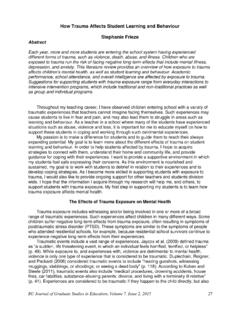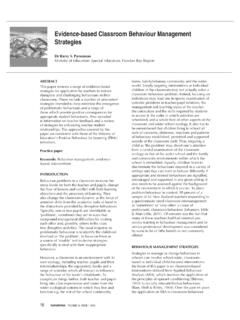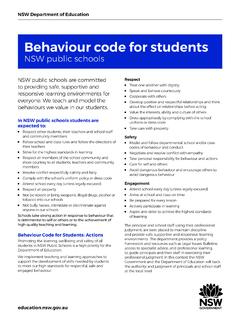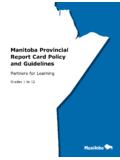Transcription of The Impact of Incentives and Rewards on Student Learning
1 ACTION RESEARCH The Impact of Incentives and Rewards on Student Learning McClean (2016) Introduction I am always ready to learn although I do not always like being taught . These words belong to the late British statesman, Winston Churchill (Langworth, 2008); but these words can also be true for any Student in the mind of a teacher. In today s classroom there are many reasons for why students are performing unsatisfactory or why students are unmotivated. Reasons one might hear are school work is too difficult, the subject matter is irrelevant and the teachers are boring just to name a few. Therefore teachers have attempted to make Learning more attractive, engaging and palatable.
2 Much research has been carried out to answer the questions of how to get students motivated and how to keep them motivated in the classroom (Harter, 1981; Hidi & Harackiewicz, 2000). As a result two schools of thought have been developed: those that hold to the constructivist theory of teaching and those who don t (Woolfolk, 2001). The constructivist approach to teaching stems from the idea that once students are actively involved in the teaching- Learning process they become more invested in their Learning and play an active role in their education (Shuell, 1996; Charles, 2011). Thus resulting in them being more motivated and eager to learn and be taught.
3 Since seeing children actively participating in class activities sometimes translates to motivation, some teachers have employed the use of Incentives to encourage and keep students motivated on tasks (Covington & Mueller, 2001; The Gale Group Inc, 2003; Ali, Tatlah, & Saeed, 2011). This action research aims to investigate the Impact of Incentives and Rewards on Student Learning . It focuses on the Impact of tangible versus intangible Rewards on Student motivation in Mathematics at the 2nd form year level. The term tangible Rewards refers to prizes and gifts; while intangible Rewards refers to words of affirmation or encouragement. The following questions are asked and the research is aimed at answering these questions.
4 1. What Impact does tangible Rewards have on Student motivation? 2. What Impact does intangible Rewards have on Student motivation? 3. What attitudes do students have towards tangible Rewards ? 4. What attitudes do students have towards intangible Rewards ? Literature Review Educational psychologists have long recognised that motivation is important for supporting Student Learning (Lai, 2011, p. 4). According to Anita Woolfolk (2001, p. 366) motivation speaks to the internal state that arouses, directs and maintains behaviour . This same motivation psychologists have discovered, can be broken down into two categories: intrinsic and extrinsic motivation (Woolfolk, 2001).
5 Intrinsic motivation refers to the engagement in an activity with no reason other than the enjoyment and satisfaction of engagement itself (The Gale Group Inc, 2003). While extrinsic motivation refers to being engaged in an activity for the sake of earning something (Giles-Brown, 2010) . The goals of extrinsically motivated engagement might be the attainment of tangible Rewards such as money, prizes or other benefits or the avoidance of punishment. Since the latter type of motivation is widely used by teachers to measure a Student s involvement in the teaching- Learning process (Baranek, 1996); this study will use this as one of the measures of Student motivation in mathematics.
6 It has been noted by Lai (2011, p. 14) that motivation for students varies from subject to subject and this may be dependent on the Student s interests. According to Gottfried (1990) motivation in mathematics appears to be related to the Student s perception of their competence and the teacher s ratings of mathematics achievement. Other researchers noted that students tend to attach more value to activities at which they excel thus making students more motivated to learn subjects in which they experience success (Eccles & Wigfield, 2002). The older children get the more their attitudes and interests tend to deteriorate with respect to subjects such as mathematics, art and science (Epstein & McPartland, 1976; Eccles & Wigfield, 1992).
7 Gottfried and colleagues (2001) also noted that motivation and self-concept for students tends to increase in age, especially as students accrue more educational experiences. Some researchers have concluded that children aged 8 11 tend to have an accurate self-perception of their strengths and weaknesses across subject areas (Guay, et al., 2010). Thus to measure the motivation in mathematics and the Impact of a Rewards system on Student motivation would be most appropriate amongst the 2nd form year group. None of these researchers mentioned the Impact of Incentives on Student motivation as it relates to mathematics hence the need for such a study. The focus of this study is on the Impact of intangible versus tangible Rewards because most educators have used Incentives as a means of eliciting extrinsic motivation (Deci, Koestner, & Ryan, 2001).
8 This practice of Incentives has gained both supporters and non-supporters. Some researchers believe that the use of Incentives to provoke a particular type of behaviour from students within the classroom is detrimental (Deci E. , 1971). These researchers hold the view that academic and social skills learned in schools should be maintained by natural consequence and not artificial Rewards . They argue that the use of Incentives leads to moral problems and damages the already existing intrinsic motivation of students (Kohn, 1994). For example they state that sharing with another child should come naturally and should not be a forced behaviour due to a Rewards system.
9 They also argue that rewarding one child for good work could have a negative effect on another Student whose work is not to that standard (Deci, Koestner, & Ryan, 2001; Horner & Spauling, 2009). These researchers all believe that Rewards systems produce children who fail to develop intrinsic and self-managed motivation because when the Rewards go so does the motivation. Many also maintain that this type of motivation comes at the expense of interest in and excellence at whatever tasks the students are performing (Kohn, 1994). On the flip side, other scholars have noted that schools have successfully employed the use of Rewards systems for decades (Slavin, 1997) and Rewards are an effective, important and fundamental part of education (Akin-Little, Eckert, Lovett, & Little, 2004; Reiss, 2005).
10 These researchers believe that Rewards can be used as stepping stones or the foundation in building the intrinsic motivation of students (Cameroon & Pierce, 1994; Horner & Spauling, 2009). What both schools of thought for and against tangible Rewards systems hold common, is that verbal Rewards or positive feedback does promote some level of enhanced intrinsic motivation (Deci, Koestner, & Ryan, 2001; Horner & Spauling, 2009). In addition, there are some researchers who hold the view that there is room for both tangible and intangible Rewards in the motivation of students to learn. They state that teachers must encourage and nurture intrinsic motivation while making sure that extrinsic motivation supports Learning (Brophy, 1988; Ryan & Deci, 1996; Deci, Koestner, & Ryan, 1999).






